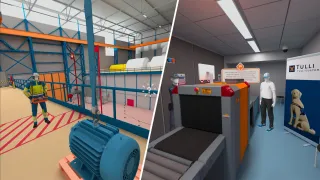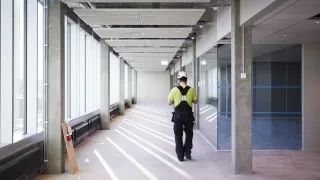University of Lapland and Finnish Institute of Occupational Health media release 28 September 2023
Occupational safety perspectives must be considered in all work tasks, regardless of sector. Occupational safety training can be made more engaging and interactive by using immersive virtual reality (IVR).
In immersive virtual reality, the learner gets acquainted with factors that promote occupational safety by using a VR headset to participate in learning scenarios that resemble real work life, with its typical challenges.
A project conducted by the University of Lapland and the Finnish Institute of Occupational Health sheds light on the possibilities that virtual reality offers for occupational safety training. Training sessions carried out in accordance with the research-based model improved occupational safety competencies effectively.
The training sessions promoted an increased focus on learning. The participants’ motivation to promote occupational safety increased and their understanding and ability to perceive dangers was strengthened. The participants also felt increasingly in control of promoting occupational safety.
“The research results provide guidelines for the development of future safety training. As the participant is more actively engaged in how events unfold in the VR environment, they are better able to recognise the impact of their own safety actions,” says Kristian Lukander, Senior Specialist for the Finnish Institute of Occupational Health.
Interaction plays an important part in learning
In the course of the project, a total of 22 occupational safety training sessions were carried out at different locations of Fortum Power & Heat Oy and the Finnish Customs. The research group developed a model that supports safety learning and enables organizations and training providers to use immersive virtual reality in a pedagogically appropriate way. The model also aids in connecting the exercises and the participants’ own experiences with the occupational safety practices of the work community.
“The Finnish Institute of Occupational Health’s Virtuario™ immerses the user in a virtual situation by efficient use of the strengths of virtual reality: presence, bodily experience and the learner’s own agency,” says Lukander.
The training sessions had a total of 76 employees as participants and five trainers, who were trained to independently carry out the actual exercises while the researchers monitored and gathered information on the progress of the learning event. A key research topic for the study was the level of interactivity between the user and the IVR environment. The results show that increased interactivity of the immersive virtual environment improved the learning results significantly.
Two versions of three different occupational safety exercises were developed for the purposes of the study: a highly interactive one and one with limited interaction. The exercises involved learning about occupational safety when working in traffic, executing a demanding lift operation in an industrial hall and adopting occupational safety knowledge related to x-ray examination in passenger traffic.
“We studied how interactivity impacted factors that are important for learning, such as cognitive load and occupational safety learning. The stimulus interviews provided a deeper understanding of the participants’ experiences and our analysis also utilised video and observation materials collected during the training,” says Professor Heli Ruokamo from the University of Lapland.
In relation to the sense of control and occupational safety knowledge, the effects of learning were still observable two and half months after the training. Compared with the initial survey, the participants who used the highly interactive VR environment reported especially more initiative in promoting occupational safety at their own workplace in the two-and-half month follow-up.
Information on the project
- Conducted in 2021–2023, the Safety Learning in Immersive Virtual Reality – SLIVeR project was carried out by the University of Lapland and the Finnish Institute of Occupational Health.
- The project received funding from the Finnish Work Environment Fund, Fortum Power & Heat and Stereoscape.
- The occupational safety training sessions were conducted at workplaces of Fortum Power & Heat and the Finnish Customs.
- The project developed the first research-based pedagogical model for integrating the use of virtual reality as part of a wider context of training or learning.
- The IVR exercises used in the project and training based on the research results are utilised in the Finnish Institute of Occupational Health’s Virtuario™ service: Virtuario™ – Occupational Safety Training in Virtual Reality
- See the project pages: Safety Learning in Immersive Virtual Reality – SLIVeR
- Link to the final report (in Finnish): Safety Learning in Immersive Virtual Reality – SLIVeR (julkari.fi)
Further information:
- Finnish Institute of Occupational Health: Kristian Lukander, Senior Specialist, kristian.lukander [at] ttl.fi (kristian[dot]lukander[at]ttl[dot]fi), tel. +358 (0)3 047 42531
- University of Lapland: Heli Ruokamo, Professor, heli.ruokamo [at] ulapland.fi (heli[dot]ruokamo[at]ulapland[dot]fi), tel. +358 (0)40 587 9090





